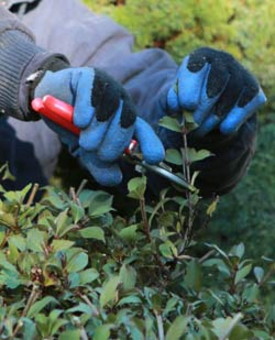 The path outside my window is thinly dappled with small brown leaves. The last I noticed it was in spring when it was completely carpeted with white cherry blossoms. The Japanese consider a carpet of flower petals a treasured joy of the spring garden, even though it lasts but a day.
The path outside my window is thinly dappled with small brown leaves. The last I noticed it was in spring when it was completely carpeted with white cherry blossoms. The Japanese consider a carpet of flower petals a treasured joy of the spring garden, even though it lasts but a day.
Now suddenly it is fall, and some leaves, browning early, float to the ground, a hint of the not so treasured carpet to soon come.
For serious gardeners, fall is a time to look around, decide what was good and what was not. Also what to do now when one needs the quiet peace and pace of garden chores in the glorious days of fall. I always enjoy pruning, but fall pruning has its caveats.
Pruning is a most complicated skill. Each cut causes a different kind of response and a different growth agenda for the plant.
1. Do not prune SPRING FLOWERING PLANTS (rhododendron, azalea, lilac, old hydrangeas, forsythia, magnolia) because they have set their flowering buds already. You will cut off next year’s blossoms. If some messy, errant shoots must be trimmed, just tidy up lightly. Any serious pruning should be done right after flowering in spring.
2. FRUIT TREES should also be pruned in spring, but before they leaf out. This pruning is to shape the tree, and also to thin the blossoms so as to balance size of the crop with the size of the tree.
Incidentally, if your fruit tree branches grow upright with few fruits, you can increase the crop with an old farmers’ trick. Tie the end of some branches to a rock to weight it down so the end is lower than where it grows off the trunk. This makes the sugars from photosynthesis stay in the branch, which encourages blossom set. (Gravity, you know.) I wish there was a good trick to keep the rotten squirrels from eating the ripening fruit, especially bad on peach trees.
3. EVERGREENS can be pruned now, as long as you don’t go below the green. But what you leave is all you will have all winter so don’t cut back too much now. New sprouts come in spring.
4. DECIDUOUS SHRUBS like privet hedge can be pruned in fall, because they lose their leaves anyway.
5. SHADE TREES are best pruned when there are no leaves, so you can see where branches come from, and analyze what effect it will have on future growth, beauty, balance and safety.
6. Most cut back ends sprout several new shoots and spread outwards.
Isaiah said, “Beat your spears into pruning hooks and learn not war anymore.” Would that all nations would heed his words.
Ruth S. Foster is a landscape consultant and arborist. More gardening info is on her website, mothersgarden.net.
Credit: Renovateyourworld.com




























